Complete Solutions to EXERCISES of chapter WAVE NATURE OF LIGHT of Class 12 book with complete answers and questions
| Class 12 | PHYSICS |
| Chapter | WAVE NATURE OF LIGHT |
| CP SINGH | EXERCISES |
| Number Of Questions | 100 |
| Academic Year | 2023-24 |
Lifgt is
00:27View SolutionThe speed of light depends
01:07View SolutionThe equation of a light wave i written as `y=Asin(kx-omegat)`. Here y represents
03:08View SolutionWhen light is refracted into a medium
01:31View SolutionWave nature of light follows because
03:17View SolutionRay optics is valid when characteristic dimensions are
01:54View SolutionLight appears to travel in straight lines since
00:56View SolutionThe velocity of light in diamond, glass and water decreases in the following order
00:44View SolutionChoose the correct option:
08:46View SolutionChoose the correct option:
(i) A surface on which the wave disturbance in same phase at all points is called a wavefront.
(ii) The direction of a wave at a point is perpendicular to the wavefront through that point.
(iii) The wavefronts of a wave originating from a point source is spherical.
The wavefronts for a wave going along a fixed direction are planes perpendicular to that direction.01:22View SolutionA wavefront and a ray of light are
00:28View SolutionHuygen's principle of secondary waves
01:05View SolutionHuygen's priciple of secondary wavelets may be used to
03:50View SolutionWhich one of the following phenomena is not explained by Huygens construction of wavefront?
01:22View SolutionBy Huygen's wave theroy of light, we cannot explain the phenomenon of
00:52View SolutionIn the adjoining figure, a wavefront AB moving in air is incident on a plane glass surface XY. Its position CD, after refraction through a glass slab is shown also along with the normals drawn at A and D. The refractive index of glass with respect to air will be equal to
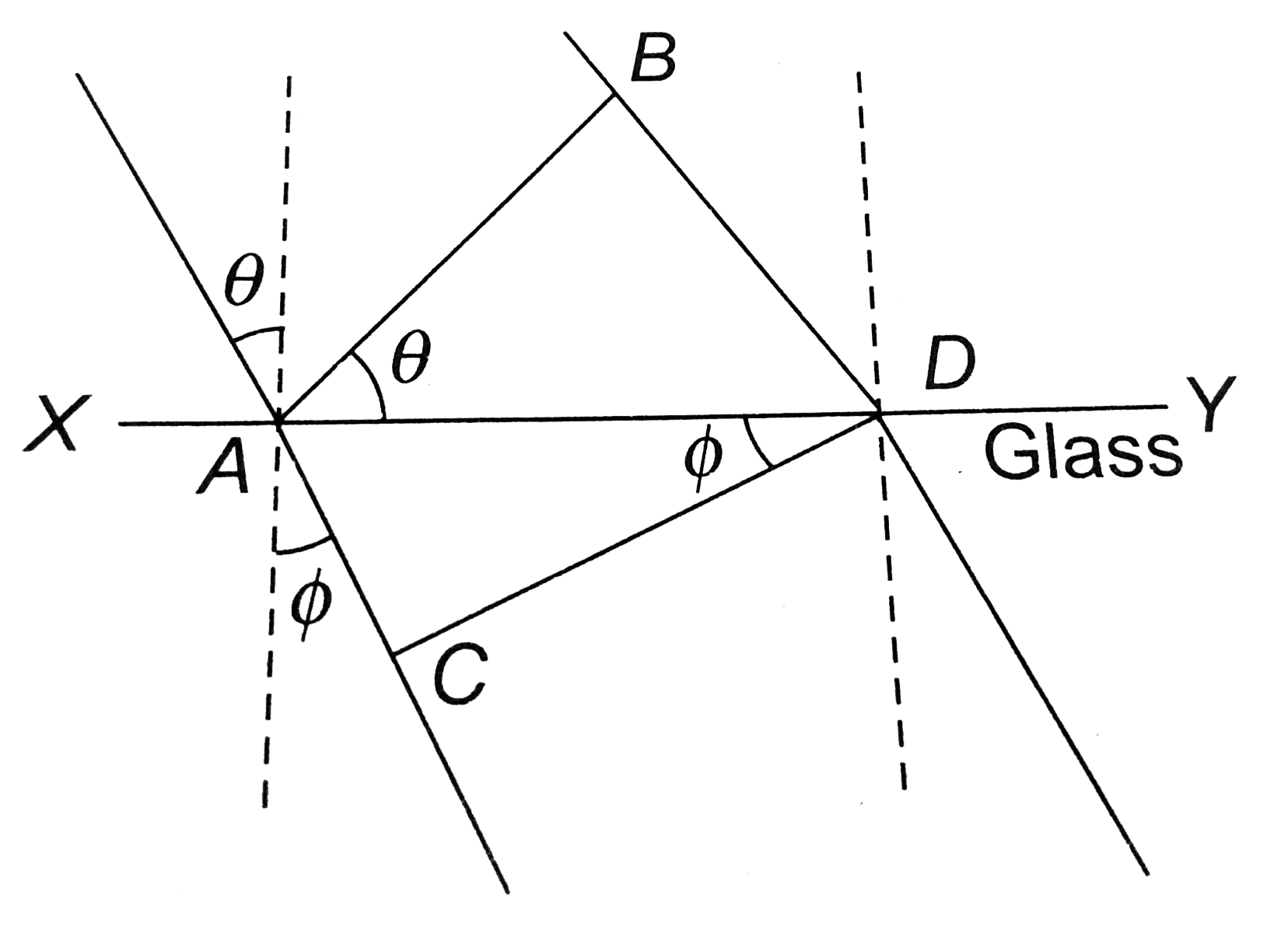 02:01View Solution
02:01View SolutionIn the adjacent diagram, CP represents a wavefront and AO & BP, the corresponding two rays. Find the condition on `theta` for constructive interference at P between the ray BP and reflected ray OP.
 07:20View Solution
07:20View SolutionWhich of the following sources gives best mionochromatic light?
03:48View SolutionA laser beam is used for carrying our surgery because it
01:48View SolutionTwo sources of light are said to be coherent if the waves produced by them have the same
01:43View SolutionTo deminstrate the phenimenon of interference, we require two sources which emit radiation
01:24View SolutionFor the sustained interference of light, the necessary condition is that the two sources should
01:14View SolutionFour light waves are represented by
`i. y=a_1sin omegat`
ii. `y=a_2sin(omegat+epsilon)`
iii. `y=a_1sin 2omegat`
iv.` y=a_2sin2(omegat+epsilon)` Inteference fringes may be observed due to superposition of05:33View SolutionYoung's experiment establishes that
01:26View SolutionThe phenomenon of interference is shown by
01:42View SolutionIn the interference pattern, energy is
02:44View SolutionFor observing sustained interferencr with good contrast, which of the following option are correct?
(i) The sources must be coherent i.e. the phase difference must remain constant.
(ii) The frequencies, wavelengths and amplitudes of interfering waves must be equal and light must be monochromatic.
(iii) The source must be close to each other and must be narrow.
(iv) If the interfering beams are polarised, they must be in the same state of polarisation.04:06View SolutionThe contrast in the fringes in an interference pattern depends on
02:06View SolutionA Young's double slit experiment uses a monochromatic source. The shape of the interference fringes formed on a screen is
02:08View SolutionIf two slightly, different wavelengths are present in the light used in Young's double-slit experiment, then
01:28View SolutionA beam of electron is used `YDSE` experiment . The slit width is d when the velocity of electron is increased ,then
01:54View SolutionIf three slits are used in Young's experiment instead of two, we get
01:31View SolutionIf a torch is used in place of monochromatic light in Young's experiment what will happen?
02:46View SolutionIf the source of light used in a young's double slit experiment is changed from red to violet
04:04View SolutionA double-slit interference experiment is set up in a chamber that can be completely evacuted. With monochromatic light, an interference pattern is observed when the container is open to air. As the container is evacuated, a careful observer will note that the interference fringes
01:36View SolutionLight of wavelength `lambda` in air enters a medium of refractive index `mu`. Two points in this medium, lying along the path of this light, are at a distance of x apartThe phase difference between these point is
01:41View SolutionRatio waves originating from sources `S_(1)` and `S_(2)` having zero phase difference and common wavelength `lambda` will show completely destructive interference at a point `P` is `S_(1)P-S_(2)P` is
04:02View SolutionIn the double-slit experiment, the distance of the second dark fringe from the central line are `3 mm`. The distance of the fourth bright fringe from the central line is
01:03View SolutionIn a Young's double slit experiment (slit distance d) monochromatic light of wavelength `lambda` is used and the figure pattern observed at a distance L from the slits. The angular position of the bright fringes are
00:57View SolutionIn Young's double slit experiment, the phase difference between the light waves reaching third bright fringe from the central fringe will be `(lambda=6000Å)`
01:23View SolutionIn the figure is shown Young's double slit experiment. Q is the position of the first bright fringe on the right side of O. P is the `11^(th)` bright fringe on the other side, as measured from Q. If the wavelength of the light used is `600 nm`. Then `S_(1)B` will be equal to
 01:34View Solution
01:34View SolutionThe Young's double slit experiment is carried out with light of wavelength `5000Å`. The distance between the slits is `0.2 mm` and the screen is at `200 cm` from the slits. The central maximum is at `y=0`. The third maximum will be at `y` equal to
01:12View SolutionTwo slits at a distance of `1mm` are illuminated by a light of wavelength `6.5xx10^-7m`. The interference fringes are observed on a screen placed at a distance of `1m`. The distance between third dark fringe and fifth bright fringe will be
03:51View SolutionA beam with wavelength `lambda` falls on a stack of partially reflecting planes with separation `d`. The angle `theta` that the beam should make with planes so that the beams reflected from successive planes may interfere constructively is (where n=1, 2, ...)
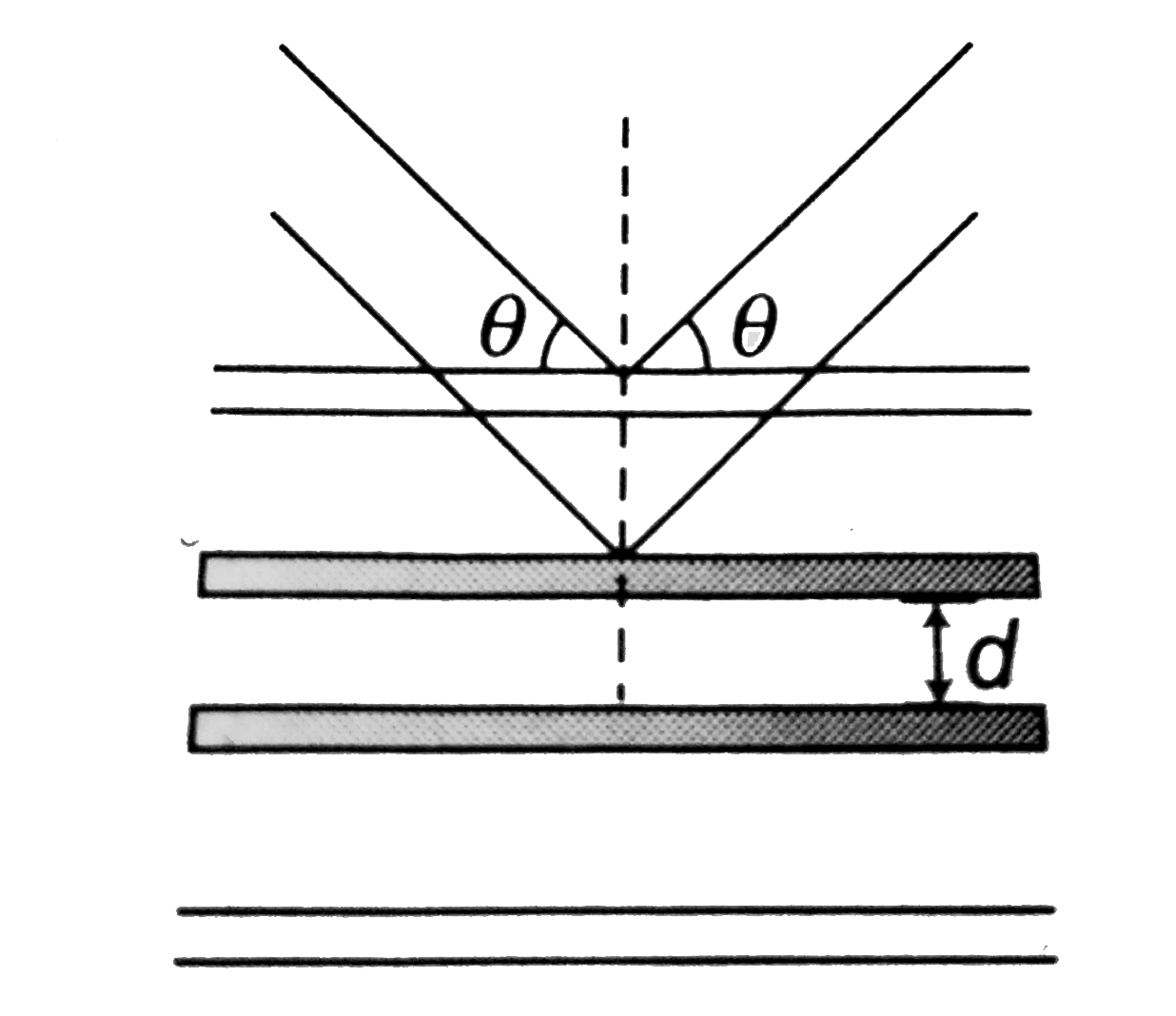 02:01View Solution
02:01View SolutionTwo point sources X and Y emit waves of same frequency and speed but Y lags in phase behind X by `2 pid` radian. If there is a maximum in direction D, the distance XO using n as an integer is given by
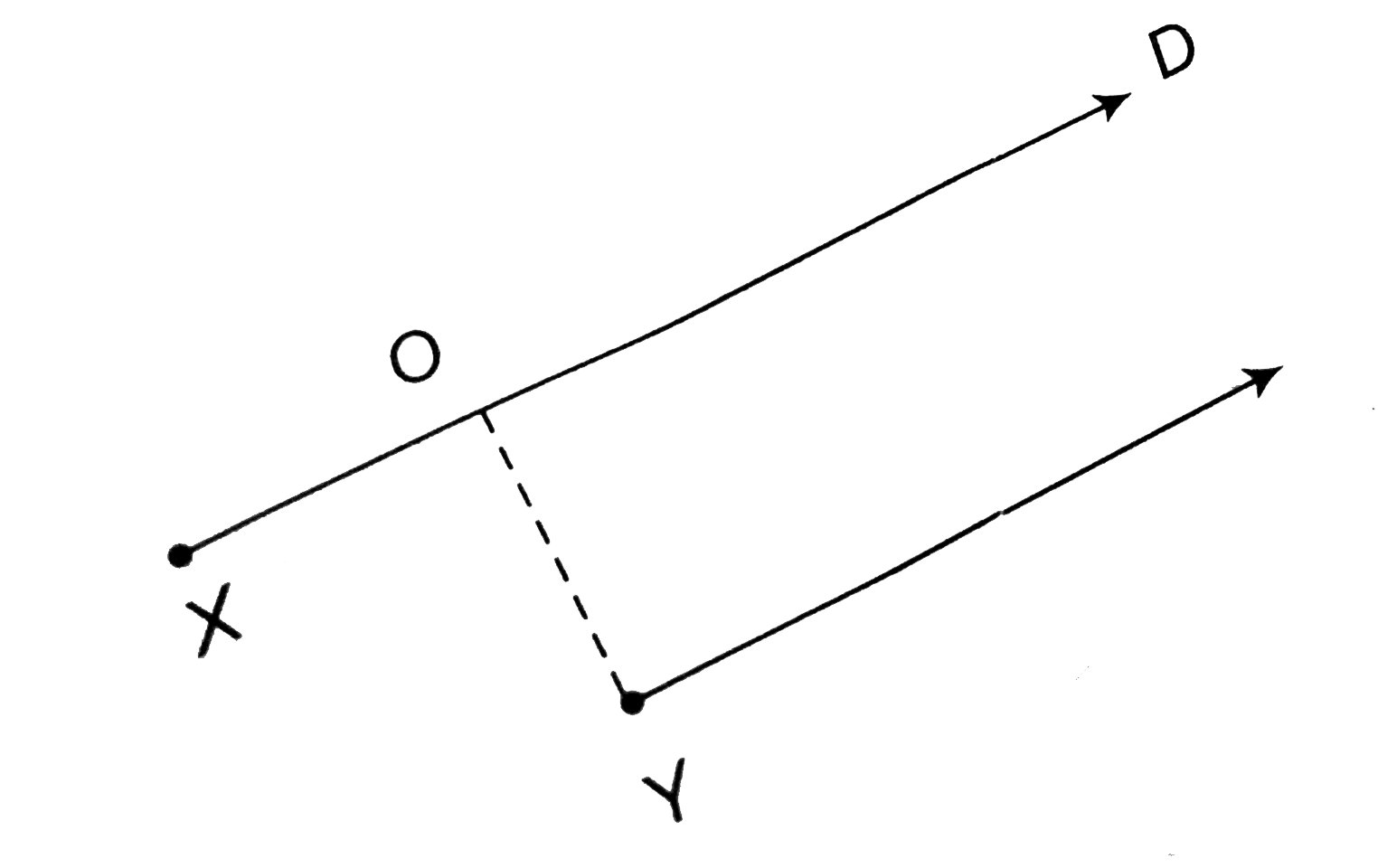 01:39View Solution
01:39View SolutionTwo ideal slits `S_(1)` and `S_(2)` are at a distance `d` apart, and illuninated by light of wavelength `lambda` passing through an ideal source slit `S` placed on the line through `S_(2)` as shown. The distance between the planes of slits and the source slit is `D.A` screen is held at a distance `D` from the plane of the slits. The minimum value of `d` for which there is darkness at `O` is `(dlt lt D)`
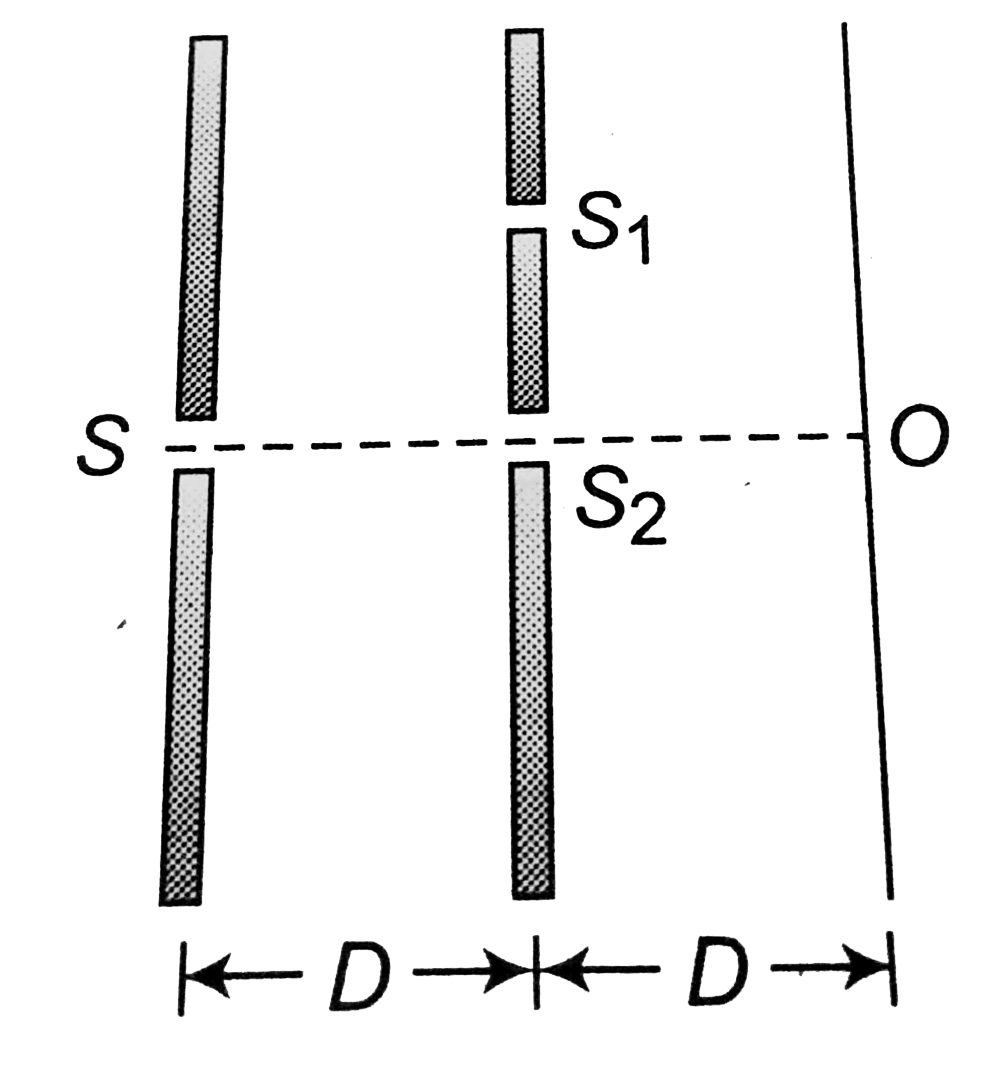 08:08View Solution
08:08View SolutionLights of wavelengths `lambda_(1)=4500 Å, lambda_(2)=6000 Å` are sent through a double slit arrangement simultaneously. Then
01:35View SolutionIn Young's double slit experiment, the wavelength of red light is `5200 Å`. The value of n for which nth bright band due to red light coincides with `(n+1)th` bright band due to blue light`(lambda=7800Angstrom)`, is
03:09View SolutionThe incident light on a Yound's experiment has wavelengths `400 nm` and `600 nm`. The distance between the two interfering sources is 2 mm and screen is at a distance of 1 m. The position from central fringe, where bright fringes of two wavelengths coincide first is at a distance of
01:56View SolutionIn Young's experiment, the distance between the slits is 0.025 cm and the distance of the screen from the slits is 100 cm. If two distance between their second maxima in cm is
01:31View SolutionWhite light is used to illuminate the two slits in a Young's
double slit experiment. The separation between the slits is b and the screen is at
a distance `d(gtgtb)` from the slits. At a point on the screen directly in front of
one of the slits, certain wavelengths are missing. Some of these missing wavelength are05:04View SolutionA Young's double slit experiment is performed with white light.
03:52View SolutionIn Young's doble-slit experiment, if the monochromatic source of light is replaced by white light, then one sees
01:31View SolutionA Young's double-slit set-up for interference shifted from air to within water. Then the
01:27View SolutionIn a YDSE, `lambda=4000 Å`, fringes observed have a width `beta`. The light illuminating the set-up now has `lambda=6000 Å` and the separation between the interfering sources is halved. What is the ratio of the distance between the screen and the interfering sources before and now if the fringe and now if the fringe width ramains unaltered
01:20View SolutionIn Young's double slit experiment, the sepcaration between the slits is halved and the distance between the slits and the screen is doubled. The fringe width is
01:23View SolutionYong's double-slit experiment is carried out by using green, red and blue light, one color at a time. The fringe widths recorded are `beta_(G),beta_(R)` and `beta_(B)`, respectively. Then
00:49View SolutionIn two separate set-ups of YDSE, using light of same wavelength, fringes of equal width are observed. If ratio of slit separation in the equal width are observed. If ratio of slit separation in the two is `2:3`, the ratio of the distance between source and screen in the two set-ups is
01:07View SolutionIn a Young's double-slit experment, the fringe width is `beta`. If the entire arrangement is now placed inside a liquid of refractive index `mu`, the fringe width will become
01:03View SolutionIn Young's double-slit experiment using `lambda=6000 Å`, distance between the screen and the source is 1m. If the fringe-width on the screen is 0.06 cm, the distance between the two coherent sources is
01:12View SolutionThe distance between two coherent sources is 0.1 mm. The fringe-width on a screen 1.2 m away from the source is 6.0 mm. The wavelength of light used is
01:02View SolutionAn interference pattern is obtained by Young's double-slit arrangement and the fringe-width is `beta`. If the distance between the slits is halved and the distance of the screen fron the slits is made three times, the new fringe-width will be tripled
01:05View SolutionIn Young's double-slit experiment , we get 60 fringes in the field of view if we use light of wavelength `4000 Å`. The number of fringes we will get in the same field of view if we use light of wavelength `6000 Å` is
01:26View SolutionIn a Young's double-slit experiment, let `S_(1)` and `S_(2)` be the two slits, and `C` be the centre of the screen. If `/_S_(1)CS_(2)=theta` and `lambda` is wavelength, the fringe width will be
02:20View SolutionThe maximum number of possible interference maxima for slit-separation equal to twice the wavelength in Young's double-slit experiment is
03:06View SolutionIn Young's double slit experiment, how many maximas can be obtained on a screen (including the central maximum) on both sides of the central fringe if `lambda=2000 Å` and `d= 7000 Å` ?
03:51View SolutionIn a Young's double-slit experiment, the intensity ratio of maxima and minima is infinite. The ratio of the amlitudes of two sources
00:57View SolutionTwo coherent monochromatic light beams of intensities I and 4I are superposed. The maximum and minimum possible intensities in the resulting beam are
02:45View SolutionInterference fringes are obtained due to the interference of wave from two coherent sources of light with amplitudes `a_(1)` and `a_(2)(a_(1)=2a_(2))`. The ratio of the maximum and minimum intensities of light in the interference pattern is
01:09View SolutionIn the Young's double-slit experiment, the interference pattern is found to have intensity ratio between gright and dark fringes as 9. This implies that
(i) the intensities at the screen due to the two slits are 5 units and 4 units respectively
(ii) the intensities st the screen due to the slits are 4 units and 1 unit respectively
(iii) the amplitude ratio is 3
(iv) the amplitude ratio is 202:55View SolutionIn Young's double slit experiment, one of the slit is wider than other, so that amplitude of the light from one slit is double of that from other slit. If `I_m` be the maximum intensity, the resultant intensity I when they interfere at phase difference `phi` is given by:
05:05View SolutionA ray of light intensity I is incident on a parallel glass-slab at a point `A` as shown in figure. It undergoes partial reflection and refraction. At each reflection `25%` of incident energy is reflected. The rays `AB` and `A^(')B^(')` undergo interference. The ratio `I_(max)//I_(min)` is
 03:20View Solution
03:20View SolutionIn a YDSE with identical slits, the intensity of the central bright fringe is `I_(0)`. If one of the slits is covered, the intensity at the same point is
01:55View SolutionThe maximum intensity of fringes in Young's experiment is I. If one of the slit is closed, then the intensity at that place becomes `I_o`. Which of the following relation is true?
03:10View SolutionIn Young's double slit experiment the intensity of light on the screen where the where the path difference is `lambda` is k ( `lambda` being the wavelength of light used). The intensity at a point where the path difference is `(lambda)/(4)` will be
03:13View SolutionIn Young's double slit experiment intensity at a point is `((1)/(4))` of the maximum intersity. Angular position of this point is
02:51View SolutionIn Young's double slit experiment, the two slits acts as coherent sources of equal amplitude A and wavelength `lambda`. In another experiment with the same set up the two slits are of equal amplitude A and wavelength `lambda` but are incoherent. The ratio of the intensity of light at the mid-point of the screen in the first case to that in the second case is
03:11View SolutionIf the intensities of the two interfering beam in Young's double-slit experiment are `I_(1)` and `I_(2)`, then the constrast between the maximum and minimum intensities are good when
01:27View SolutionIn Young's interference experiment, if the slit are of unequal width, then
03:07View SolutionIn Young's experiment with one source and two slits, one of the slits is covered with black paper. Then
01:14View SolutionIn Young's interference expriment with one source and two slits, one slit is covered with a cellophane of sheet which absorbs half the intensity. Then
02:06View SolutionThree waves of equal frequency having amplitudes `10mum`, `4mum`, `7mum` arrive at a given point with successive phase difference of `pi//2`, the amplitude of the resulting wave in `mum` is given by
03:13View SolutionFig, here shows P and Q as two equally intense coherent sources emitting radiations of wavelength 20m. The separation PQ si 5m, and phase of P is ahead of the phase Q by `90^(@)`. A, B and C are three distant points of observation equidistant from the mid - point of PQ. The intensity of radiations of A, B, C will be in the ratio
 08:16View Solution
08:16View SolutionIn Young's experiment, monochromatic light is used to illuminate the two slits A and B. Interference fringes are observed on a screen placed in front of the slits. Now if a thin glass plate is placed normally in the path of the beam coming from the slit
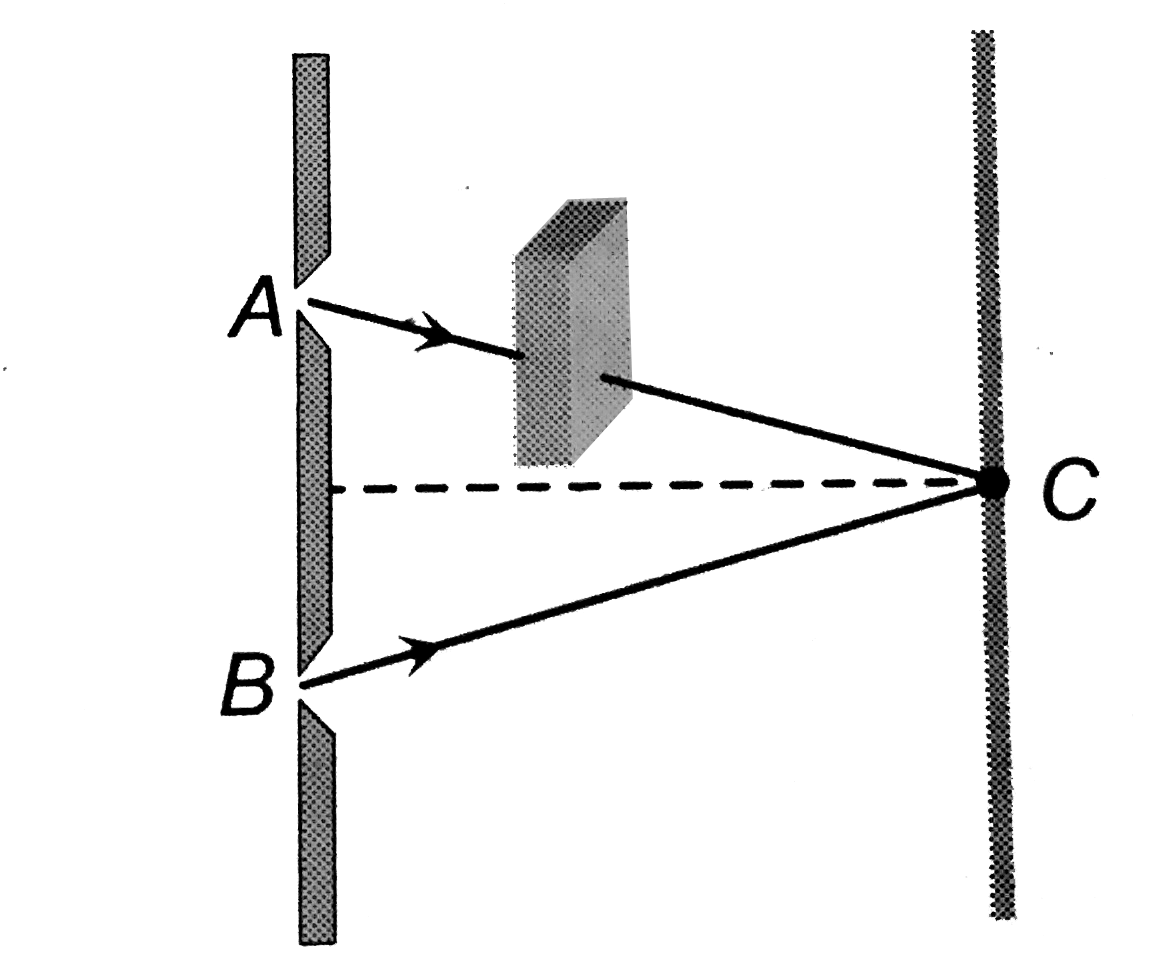 02:17View Solution
02:17View SolutionIn a Young's double-silt experiment the source slit S and the two slits A and B are horizontal with slit A above slit B. The fringe are observed on a vertical screen. The optical path length from S to B is increased slightly by introducing a tranparent slab. As a result the fringe pattern on the screen moves
01:57View SolutionWhen a transparent parallel plate of uniform thickness `t` and refractive index `mu` is interposed normally in the path of a beam of light, the optical path is
01:07View SolutionLight of wavelength `5000 Å` is travelling in air. A thin glass plate (mu=1.5) of thickness `1 mm` is placed in the path of light. The change in phase of light is
01:23View SolutionIf a transparent medium of refractive index `mu=1.5` and thickness `t=2.5xx10^-5m` is inserted in front of one of the slits of Young's Double Slit experiment, how much will be the shift in the interference patten? The distance between the slits is `0.5mm` and that between slits and screen is `100cm`
05:07View SolutionA thin sheet of glass (refractive index 1.5) of thickness 6 microns, introduced in the path of one of the interfering beams in a double-slit experiment shift the central fringe to a position earlier occupied by the fifth bright fringe. The wavelength of light used is
01:32View SolutionA thin mica sheet of thickness `2xx10^-6m` and refractive index `(mu=1.5)` is introduced in the path of the first wave. The wavelength of the wave used is `5000Å`. The central bright maximum will shift
01:55View SolutionInterference fringes were produced in Young's double-slit experiment using light of wavelength `5000 Å`. When a film of thickness `2.5xx10^(-3) cm` was placed in front of one of the slits, the fringe pattern shifted by a distance equal to `20` fringe-widths. The refractive index of the material of the film is
01:39View SolutionWhen one of the slits of Young's experiment is covered with a transparent sheet of thickness `4.8mm`, the central fringe shifts to a position originally occupied by the 30th bright fringe. What should be the thickness of the sheet if the central fringe has to shift to the position occupied by 20th bright fringe?
02:10View SolutionIn the ideal double-slit experiment, when a glass-plate (refractive index 1.5) of thickness t is introduced in the path of one of the interfering beams (wavelength `lambda`), the intensity at the position where the central maximum occurred previously remains unchanged. The minimum thickness of the glass-plate is
02:08View SolutionA monochromatic beam of light fall on YDSE apparatus at some angle (say `theta`) as shown in figure. A thin sheet of glass is inserted in front of the lower slit `s_(2)`. The central bright fringe (path difference `= 0`) will be obtained
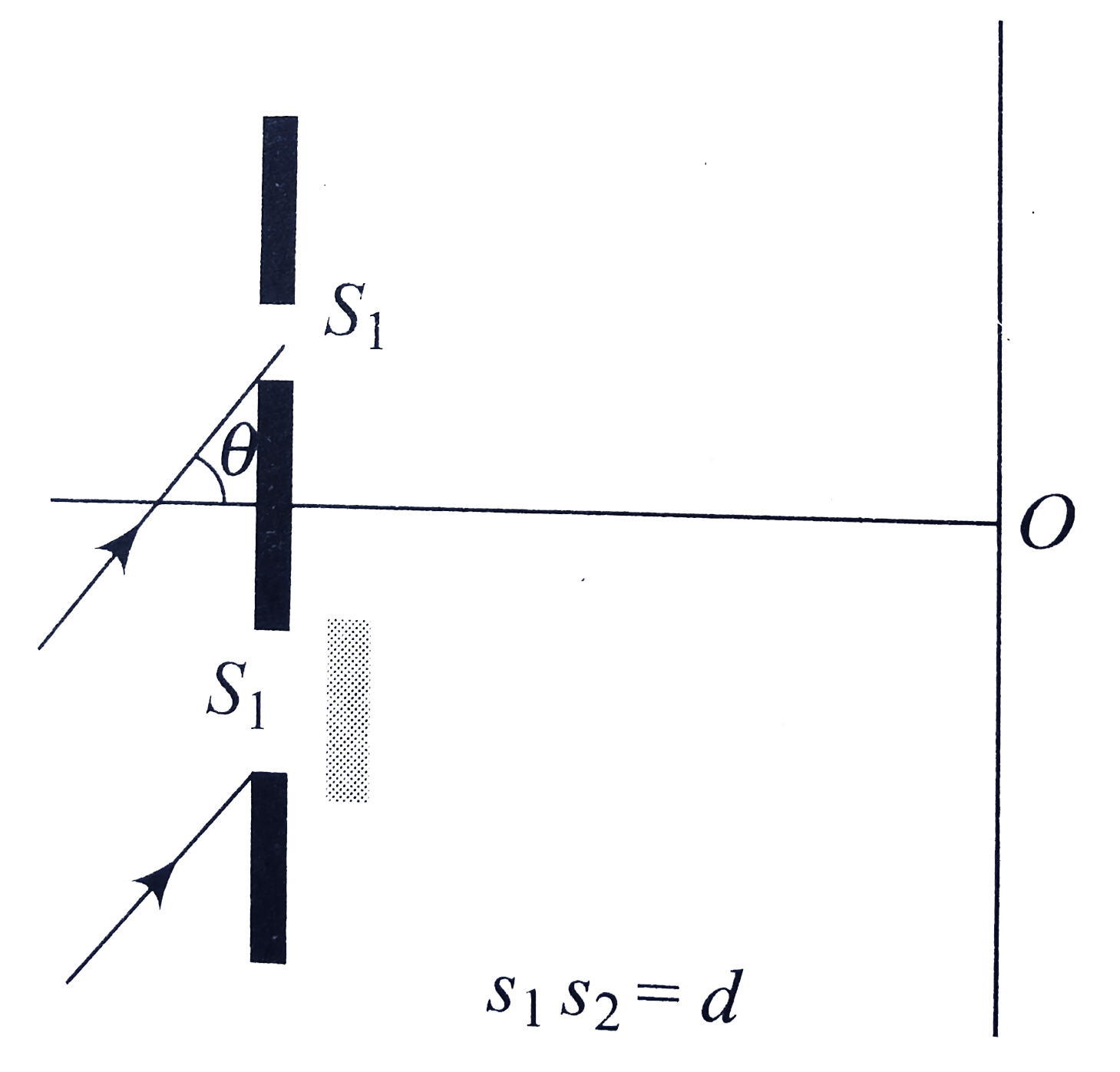 03:03View Solution
03:03View SolutionIn double slit experiment fringes are obtained using light of wavelength `4800 Å` One slit is covered with a thin glass film of refractive index. `1.4` and another slit is covered by a film of same thickness but refractive index `1.7`. By doing so, the central fringe is shifted to fifth bright fringe in the original pattern. The thickness of glass film is
06:58View SolutionWhen exposed to sunlight, thin films of oil on water often exhibit brilliant colours due to the phenomenon of
02:20View SolutionWhen viewed in white light, soap bubbles show colours because of
01:02View SolutionA parallel beam of sodium light of wavelength `6000 Å` is incident on a thin glass plate of `mu=1.5`, such that the angle of refraction in the plate is `60^(@)`. The smallest thickness of the plate which will make it appear dark by reflected light is
02:44View SolutionIf wavelength `4500 Å` and `6000 Å` are found to be missing in the reflected spectrum in thin air film interference, the thickness of the film for normal incidence is nearly
02:31View SolutionWhite light may be considered to be mixture of waves of `lambda` ranging between `3900 Å` and `7800 Å`. An oil film of thickness `10,000 Å` is examined normally by the reflected light. If `mu=1.4`, then the film appears bright for
02:15View Solution
EXERCISES questions and complete solutions for chapter WAVE NATURE OF LIGHT of CP SINGH PHYSICS (HINGLISH) of Class 12
